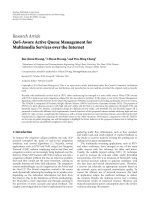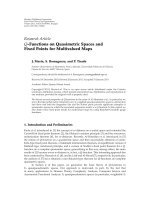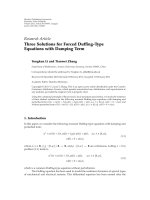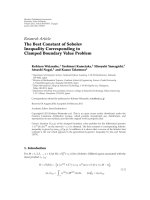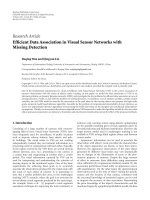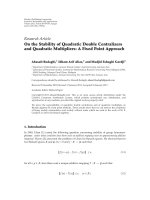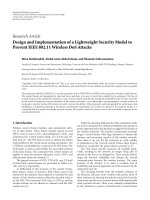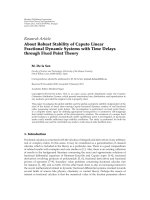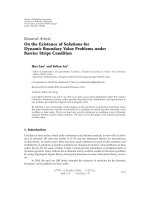Báo cáo hóa học: " Research Article Subjective Quality Assessment of H.264/AVC Video Streaming with Packet Losses" potx
Bạn đang xem bản rút gọn của tài liệu. Xem và tải ngay bản đầy đủ của tài liệu tại đây (4.53 MB, 12 trang )
Hindawi Publishing Corporation
EURASIP Journal on Image and Video Processing
Volume 2011, Article ID 190431, 12 pages
doi:10.1155/2011/190431
Research Article
Subjective Quality Assessment of H.264/AVC Video
Streaming with Packet Losses
Francesca De Simone,1 Matteo Naccari,2 Marco Tagliasacchi,3 Frederic Dufaux,4
Stefano Tubaro,3 and Touradj Ebrahimi (EURASIP Member)1
1 Multimedia
Signal Processing Group (MMSPG), Ecole Polytechnique F´d´rale de Lausanne (EPFL), 1015 Lausanne, Switzerland
e e
de Telecomunicacoes, Instituto Superior T´cnico, 1049-011 Lisboa, Portugal
¸˜
e
3 Dipartimento di Elettronica e Informazione, Politecnico di Milano (PoliMI), 20133 Milano, Italy
4 Telecom ParisTech, 75634 Paris Cedex 13, France
2 Instituto
Correspondence should be addressed to Francesca De Simone, francesca.desimone@epfl.ch
Received 15 November 2010; Accepted 18 January 2011
Academic Editor: Vittorio Baroncini
Copyright © 2011 Francesca De Simone et al. This is an open access article distributed under the Creative Commons Attribution
License, which permits unrestricted use, distribution, and reproduction in any medium, provided the original work is properly
cited.
Research in the field of video quality assessment relies on the availability of subjective scores, collected by means of experiments
in which groups of people are asked to rate the quality of video sequences. The availability of subjective scores is fundamental
to enable validation and comparative benchmarking of the objective algorithms that try to predict human perception of video
quality by automatically analyzing the video sequences, in a way to support reproducible and reliable research results. In this
paper, a publicly available database of subjective quality scores and corrupted video sequences is described. The scores refer to 156
sequences at CIF and 4CIF spatial resolutions, encoded with H.264/AVC and corrupted by simulating the transmission over an
error-prone network. The subjective evaluation has been performed by 40 subjects at the premises of two academic institutions,
in standard-compliant controlled environments. In order to support reproducible research in the field of full-reference, reducedreference, and no-reference video quality assessment algorithms, both the uncompressed files and the H.264/AVC bitstreams, as
well as the packet loss patterns, have been made available to the research community.
1. Introduction
The use of IP networks for video delivery is gaining an
increasing popularity as a mean of broadcasting data from
content providers to consumers. Video transmission over
peer-to-peer networks is also becoming very popular. Typically, these networks provide only best-effort services, that
is, there is no guarantee that the content will be delivered
without errors. In practice, the received video sequence may
be a degraded version of the original. Besides distortions
introduced by lossy coding, user’s experience might be also
affected by channel-induced distortions. Thus, the design
of systems for automatic monitoring of the received video
quality is of great interest for service providers, in order
to optimize the transmission strategies as well as to ensure
a desired level of quality of experience. Several algorithms,
usually referred to as objective quality metrics, have been
proposed in the literature for the in-service objective quality
evaluation of video sequences. They consist of No-Reference
or Reduced-Reference methods relying on the analysis of the
bitstream, the pixels, or both (so-called hybrid approach)
[1, 2]. Nevertheless, the lack of publicly available databases of
video sequences and subjective scores makes the comparison
of existing and novel solutions very difficult.
In fact, research in the field of video quality assessment
relies on the availability of subjective scores, collected by
means of experiments in which groups of people are asked
to rate the quality of video sequences. In order to gather
reliable and statistically significant data, subjective tests
have to be carefully designed and performed and require a
large number of subjects. For these reasons, the subjective
tests are usually very time consuming. Nevertheless, the
availability of subjective scores is fundamental to enable
validation and comparative benchmarking of objective video
2
quality metrics in a way to support reproducible and reliable
research results.
The first public database of video contents and related
subjective quality scores was produced by the Video Quality Experts Group (VQEG) and used to compare the
performance of Full-Reference objective metrics, targeting
secondary distribution of television as application [3].
Unfortunately, only part of the subjective results and test
materials used to perform the study has been made publicly
available. Additionally, this dataset includes interlaced video
sequences and focuses on MPEG-2 compression. These
distortions are not representative of the current video
coding and transmission technologies. Thus, the usage of
VQEG data by independent researchers to validate more
recent and future metrics is limited. Recently, two video
databases have been proposed by the Laboratory for Image
and Video Engineering (LIVE) at the University of Texas
at Austin. The LIVE Video Quality Database [4] consists
of a set of video sequences corresponding to different
contents, distorted by MPEG-2 and H.264/AVC compression
as well as by transmission over error-prone IP and wireless
networks. The presence of diverse distortion types makes this
database particularly useful to test the consistency of metrics
performance. The LIVE Wireless Video Quality Assessment
Database [5] focuses on distortions due to transmission
over a wireless network and takes into account a set of
video sequences having similar content concerning airplanes.
These databases include the test video sequences and the
processed subjective results and have been used to evaluate
the performance of a set of Full-Reference video quality
metrics in [4, 5].
In this paper, a detailed description of the publicly
available database originally presented in [6] and extended
in [7] is provided, along with an extensive discussion of the
data processing applied to the collected subjective scores and
analysis of the results. The database focuses on the impact of
packet losses on visual quality. It contains subjective scores
collected through subjective tests carried out at the premises
of two academic institutions: Ecole Polytechnique F´ d´ rale
e e
de Lausanne-Switzerland and Politecnico di Milano-Italy.
The same experiments were performed at both laboratories
and a total of 40 subjects were asked to rate 144 video
sequences, corresponding to 12 different video contents at
CIF and 4CIF spatial resolutions and different Packet Loss
Rates (PLRs), ranging from 0.1% to 10%. The packet loss free
sequences were also included in the test material, thus in total
156 sequences were rated by each subject at each institution.
With respect to others cited above, the database described
in this paper, (1) includes data collected at the premises of
two different laboratories, showing high correlation among
the two sets of collected results, as an indicator of reliability
of the subjective data as well as of the adopted evaluation
methodology, (2) includes the decoded sequences and the
compressed video streams affected by packet losses, as
well as the packet loss patterns, thus it can be used for
testing stream-based and hybrid No-Reference and ReducedReference metrics, (3) includes the complete set of collected
subjective results, including the raw scores before any data
processing, thus allowing reproducible research on subjective
EURASIP Journal on Image and Video Processing
data processing and detailed statistical analysis of metrics
performance. The database is available for download at
fl.ch/vqa and .
The rest of the paper is organized as follows. Section 2
describes the test material, the environmental setup, and
the subjective evaluation methodology used in our study.
In Section 3, the processing of the results is detailed. The
results of the two laboratories are analyzed and compared in
Section 4. Finally, Section 5 concludes the paper.
2. Subjective Video Quality Assessment
In a subjective video quality test, a group of people is asked to
watch a set of video sequences and to rate their quality. The
design of formal subjective experiments involves four main
phases [8–10]:
(1) Selection of the Test Material. The test material has
to be a realistic sample of the actual data that belongs
to the target application scenario. Also, in order to avoid
decreasing subject’s level of attention, the content has to be
heterogeneous and the test sessions should not last more
than 30 minutes each, including any training phase. For the
same reason, it is important to select stimuli whose quality
levels are possibly uniformly distributed across the rating
scale. Therefore, an accurate supervised screening of the test
material is needed. Whenever it is not possible to show the
entire set of the test materials in a single test session (for
instance, because the duration of the session exceeds 30
minutes), multiple sessions may be scheduled, so that each
subject is able to perform all the sessions and rate all the test
material (i.e., full factorial design). Alternatively, a reduced
subset of test conditions may be selected.
(2) Selection of the Test Methodology. Several internationally
accepted test methods for subjective video quality assessment are described in [11, 12]. A first taxonomy of the
methods regards how the visual stimuli are presented to
the viewer. In Double Stimulus methods, the observer is
sequentially presented with two video sequences: one of
the two sequences is the reference stimulus and the other
is the test stimulus. The observer can be asked to rate
either both stimuli, or only the test stimulus. In Single
Stimulus methods, only one stimulus is shown and has to
be rated. Finally, in Stimulus Comparison methods, pairs
of stimuli are shown simultaneously and the subject is
asked to compare their quality. A second classification of
test methodologies concerns the rating scale in which the
subject is asked to express her/his quality evaluation score.
A first distinction is between continuous and discrete scales.
A second distinction pertains the use of either a categorical
scale (textual labels, describing the quality of the stimulus
or the annoyance of the impairments) or a numerical scale.
Finally, the subject may be asked to enter her/his rating after
the visualization of the test material, and/or directly while
watching the video sequence. Such continuous evaluations
can be used to elicit an indication of the temporal quality
variations across the sequence.
EURASIP Journal on Image and Video Processing
(3) Selection of the Participants. In order to gather statistically significant data, subjective tests require a large
enough number of subjects, as a representative sample of the
population of interest. The participants to the test have to be
screened for visual acuity and color blindness. They can be
chosen from two categories of end users depending on the
goal of the investigation: expert or naive, that is, nonexpert.
(4) Choice of the Experimental Setup. The experimental setup
should reproduce the viewing conditions of the target application scenario, while keeping under control all the external
experimental parameters which could influence subject’s
perception. Some recommendations and setup parameters
are indicated in [11, 13]. An accurate control of the test
environment is necessary to ensure the reproducibility of
the test activity and to compare results across different
laboratories and test sessions.In the following, the test
material, the environment setup, the subjective evaluation
methodology, and the panel of subjects used in our study are
described.
2.1. Test Material. To produce the test material for the subjective evaluation campaign, twelve video sequences in raw
progressive format and 4 : 2 : 0 chrominance subsampling
ratio were considered. Six sequences, namely, Foreman, Hall,
Mobile, Mother, News, and Paris, had CIF spatial resolution
(352 × 288 pixels) and frame rate equal to 30 fps. The
other six sequences, namely, Ice, Harbour, Soccer, CrowdRun,
DucksTakeoff, and ParkJoy, had 4CIF spatial resolution (704
× 576 pixels). The former three sequences were available at
30 fps. The latter three sequences were obtained by cropping
HD resolution video sequences down to 4CIF resolution and
downsampling the original content from 50 fps to 25 fps.
These sequences were selected because they represented
different levels of spatial and temporal complexity. The
complexity was quantified by means of Spatial Information
(SI) and Temporal Information (TI) indexes [12]. The SI
and TI indexes computed on the luminance component of
each sequence [12] are shown in Figure 1. The first frame of
each test sequence is shown in Figures 2 and 3. Furthermore,
four additional sequences, two for each spatial resolution,
were used for training, as detailed in Section 2.3, namely,
Coastguard and Container at CIF resolutions, City and Crew
at 4CIF resolutions. All sequences were 10 seconds long.
Before simulating packet losses, the sequences were
compressed using the H.264/AVC reference software, version
JM14.2, available for download at [14]. All sequences were
encoded using the High Profile to enable B-pictures and
Context Adaptive Binary Arithmetic Coding (CABAC) for
coding efficiency. Each frame was divided into a fixed
number of slices, where each slice consisted of a full row of
macroblocks. The rate control was disabled, as it introduced
visible quality fluctuations along time for some of the video
sequences. Instead, a fixed Quantization Parameter (QP)
was carefully selected for each sequence so as to ensure
high visual quality in absence of packet losses. Each coded
sequence was visually inspected in order to check whether
the chosen QPs minimized the blocking artifacts induced
3
Table 1: H.264/AVC encoding parameters.
Reference software
Profile
Number of frames
Chroma format
GOP size
GOP structure
Number of reference frames
Slice mode
Rate control
Macroblock partitioning for
motion estimation
Motion estimation algorithm
Early skip detection
Selective intramode decision
JM14.2
High
298
4:2:0
16
IBBPBBPBBPBBPBB
5
Fixed number of macroblocks
Disabled, fixed QP (Table 2)
Enabled
Enhanced Predictive Zonal
Search (EPZS)
Enabled
Enabled
by lossy coding. Table 1 illustrates the parameters used to
generate the compressed bitstreams and Table 2 the bit-rates
and PSNR values corresponding to the selected QPs for all
the test sequences.
For each of the twelve original H.264/AVC bitstreams, a
number of corrupted bitstreams were generated, by dropping
packets according to a given error pattern [15]. Coded slices
belonging to the first frames were not corrupted, as they
contained header information (Picture Parameter Set (PPS)
and Sequence Parameter Set (SPS)). Conversely, the remaining slices might be discarded from the coded bitstream.
To simulate burst errors, the patterns were generated at
six different PLRs, 0.1%, 0.4%, 1%, 3%, 5%, 10%, with a
two-state Gilbert’s model [16]. The model parameters were
tuned to obtain an average burst length of 3 packets, which
is a typical characteristic of IP networks [17]. The twostate Gilbert’s model generated, for each PLR, several error
patterns. For each PLR and content, two decoded video
sequences were manually selected in order to uniformly
span a wide range of distortions, that is, perceived video
quality, while keeping the size of the dataset manageable.
The details of the selection procedure can be found in
[6]. A total of 72 CIF sequences with packet losses and 72
4CIF sequences with packet losses were included in the test
material. Each bitstream was decoded with the H.264/AVC
reference software decoder with motion-compensated error
concealment turned on [18].
2.2. Environment Setup. Each test session involved only one
subject per display assessing the test material. The CIF and
4CIF sequences were presented in two separate test sessions.
Subjects were seated directly in line with the center of the
video display at a specified viewing distance, equal to 6–8 H
for CIF sequences and to 4–6 H for 4CIF sequences [13],
where H denotes the native height of the video window in the
screen. Table 3 summarizes the specifications of the display
devices. The ambient lighting system in both laboratories
consisted of neon lamps with color temperature of 6500 K.
4
EURASIP Journal on Image and Video Processing
60
40
35
55
Foreman
Mobile
30
ParkJoy
50
Soccer
News
CrowdRun
45
TI
TI
25
40
20
15
Harbour
35
Paris
10
5
DucksTakeOff
30
Mother
5
Hall
10
15
20
25
25
Ice
8
10
12
14
SI
16
18
20
SI
(a)
(b)
Figure 1: Spatial Information (SI) and Temporal Information (TI) indexes computed on the luminance component of the selected (a) CIF
and (b) 4CIF video sequences [12].
(a)
(b)
(c)
(d)
(e)
(f)
Figure 2: First frame of each CIF test sequence: (a) Foreman, (b) Hall, (c) Mobile, (d) Mother, (e) News, and (f) Paris.
Table 2: Test sequences and coding conditions.
Sequence name
Foreman
News
Mobile
Mother
Hall
Paris
Ice
Soccer
Harbour
CrowdRun
DucksTakeOff
ParkJoy
Spatial res. and fps
CIF 30 fps
CIF 30 fps
CIF 30 fps
CIF 30 fps
CIF 30 fps
CIF 30 fps
4CIF 30 fps
4CIF 30 fps
4CIF 30 fps
4CIF 25 fps
4CIF 25 fps
4CIF 25 fps
MB/slice
22
22
22
22
22
22
44
44
44
44
44
44
Bit-rate (kbps)
353
283
532
150
216
480
1325
2871
5453
6757
7851
6187
PSNR (db)
34.4
37.3
28.3
37.0
36.2
33.6
40.8
37.2
36.3
33.4
30.4
31.4
QP
32
31
36
32
32
32
28
28
28
30
34
32
EURASIP Journal on Image and Video Processing
5
(a)
(b)
(c)
(d)
(e)
(f)
Figure 3: First frame of each 4CIF test sequence: (a) Crowdrun, (b) DucksTakeOff, (c) Harbour, (d) Ice, (e) Parkjoy, and (f) Soccer.
Table 3: Specifications of LCD display devices.
EPFL
PoliMI
Type
Eizo CG301W
Samsung SyncMaster 920N
Diagonal size
30 inches
19 inches
1280 × 1024 (native)
Resolution
2560 × 1600 (native)
Calibration tool EyeOne Display 2
EyeOne Display 2
Gamut
sRGB
sRGB
White point
D65
D65
120 cd/m2
Brightness
120 cd/m2
Black level
minimum
minimum
Vote:
Excellent
Good
Fair
Poor
Bad
Done
2.3. Test Methodology. The Single Stimulus (SS) method was
used to collect the subjective data. Thus, each processed
video sequence was presented alone, without being paired
with its unprocessed, that is, reference, version. However,
the test procedure included a reference version of each video
sequence, which in this case was the packet loss free sequence,
as a freestanding stimulus for rating like any other. At the end
of each test presentation, a voting time followed, when the
subjects were asked to rate the quality of the stimulus using a
five-point ITU continuous adjectival scale.
A dedicated Matlab-based GUI was developed to present
the stimuli and the rating scale. The video sequences
were shown at their native resolutions, centered in a
grey-128 background window at full screen. To show the
uncompressed video sequences without adding temporal
impairments due to rendering latency, an optimized media
player [19] was used, embedded into the GUI, and the
workstations of the two laboratories were equipped with
high performance video servers. Figure 4 shows the rating
window presented to the subjects. It was decided not to limit
the voting time and to present the next stimulus only after
pressing the “Done” button. The subject could not proceed
Figure 4: Five-point continuous adjectival quality scale [12].
with the test unless she/he entered a score. Note that although
a continuous adjectival quality scale in the range 0 to 5
was adopted, the numerical values were used only for data
analysis and were not shown to the subjects.
Each test session referred to a single spatial resolution
(i.e., either CIF or 4CIF) and included 83 video sequences:
6 × 12 test sequences, that is, realizations corresponding
to 6 different contents and 6 different PLRs; 6 reference
sequences, that is, packet loss free video sequences; 5
stabilizing sequences, that is, dummy presentations shown at
the beginning of the experiment to stabilize observers’ opinion. The dummy presentations consisted in 5 realizations,
corresponding to 5 different quality levels, selected from the
test video sequences. The results for these items were not
registered by the evaluation software but the subject was not
told about this. The presentation order for each subject was
randomized, discarding those permutations where stimuli
related to the same original content were consecutive.
6
EURASIP Journal on Image and Video Processing
Scores distribution after normalization
Score
Score
Scores distribution before normalization
5
4.5
4
3.5
3
2.5
2
1.5
1
0.5
0
5
4.5
4
3.5
3
2.5
2
1.5
1
0.5
0
1 2 3 4 5 6 7 8 9 10 11 12 13 14 15 16 17
Subject
1 2 3 4 5 6 7 8 9 10 11 12 13 14 15 16 17
Subject
(a)
(b)
Figure 5: Effect of the normalization over EPFL scores for CIF data: distribution of the raw data (a) before and (b) after normalization.
CIF resolution
5
4.5
4
4
3.5
3.5
MOS value
4.5
MOS value
4CIF resolution
5
3
2.5
2
3
2.5
2
1.5
1.5
1
1
0.5
0.5
0
0
10
20
30
40
50
Video sequence
60
70
(a)
0
0
10
20
30
40
50
Video sequence
60
70
(b)
Figure 6: Distribution of MOS values obtained by PoliMI (o) and EPFL (x) laboratories for (a) CIF content and (b) 4CIF content.
Before each test session, written instructions were provided to subjects to explain their task. Additionally, a training
session was performed to allow viewers to familiarize with
the assessment procedure and the software user interface.
The contents shown in the training session were not used in
the test sessions and the data gathered during the training
was not included in the final test results. In particular, for
the training phase two different contents for each spatial
resolution and five realizations of each, representatives of
the score labels depicted in Figure 4, were used. During the
display of each training sequence, the operator explained
the meaning of each label, as summarized in the written
instructions reported in Appendix A.
The entire set of test sessions was performed in each
laboratory. Twenty-three and twenty-one subjects took part
in the CIF and 4CIF sessions, respectively, at PoliMI. Seventeen and nineteen subjects took part in the CIF and 4CIF
sessions, respectively, at EPFL. All subjects reported that they
had normal or corrected to normal vision. Their age ranged
from 24 to 40 years old. All observers were naive subjects.
3. Subjective Data Processing
Some general guidelines for processing the results of quality
assessment experiments are detailed in [11] but, when
dealing with subjective data, the statistical tools to be used
need to be selected according to the properties of the data
under analysis. Thus, a case-by-case approach is preferable.
In general, the results of a subjective experiment for
quality assessment are summarized by averaging the scores
assigned by the panel of observers to each video sequence,
that is, stimulus, in order to obtain a Mean Opinion Score
(MOS) and corresponding Confidence Interval (CI) [11].
Prior to the MOS computation, a correction procedure,
that is, normalization, to compensate for any systematic
differences in the usage of the rating scale by the different
EURASIP Journal on Image and Video Processing
7
Content: foreman
Content: hall
4
4
3
3
MOS
5
MOS
5
2
2
1
1
0
0
0
0.1 a 0.1 b 0.4 a 0.4 b 1 a
1b
3a
3b
5a
5 b 10 a 10 b
0
0.1 a 0.1 b 0.4 a 0.4 b 1 a
Test condition
1b
3a
3b
5a
5 b 10 a 10 b
5a
5 b 10 a 10 b
5a
5 b 10 a 10 b
Test condition
(a)
(b)
Content: mobile
Content: mother
4
4
3
3
MOS
5
MOS
5
2
2
1
1
0
0
0
0.1 a 0.1 b 0.4 a 0.4 b 1 a
1b
3a
3b
5a
5 b 10 a 10 b
0
0.1 a 0.1 b 0.4 a 0.4 b 1 a
Test condition
1b
3a
3b
Test condition
(c)
(d)
Content: news
Content: paris
5
4
4
3
3
MOS
MOS
5
2
2
1
1
0
0
0
0.1 a 0.1 b 0.4 a 0.4 b 1 a
1b
3a
3b
5a
5 b 10 a 10 b
0
0.1 a 0.1 b 0.4 a 0.4 b 1 a
Test condition
EPFL
PoliMI
1b
3a
3b
Test condition
EPFL
PoliMI
(e)
(f)
Figure 7: MOS values and 95% confidence intervals obtained by PoliMI and EPFL laboratories for CIF contents.
8
EURASIP Journal on Image and Video Processing
Content: crowdrun
Content: duckstakeoff
5
4
4
3
3
MOS
MOS
5
2
2
1
1
0
0
0
0.1 a 0.1 b 0.4 a 0.4 b 1 a
1b
3a
3b
5a
0
5 b 10 a 10 b
0.1 a 0.1 b 0.4 a 0.4 b 1 a
1b
3a
3b
5a
5 b 10 a 10 b
5a
5 b 10 a 10 b
5a
5 b 10 a 10 b
Test condition
Test condition
(a)
(b)
Content: harbour
Content: ice
4
4
3
3
MOS
5
MOS
5
2
2
1
1
0
0
0
0.1 a 0.1 b 0.4 a 0.4 b 1 a
1b
3a
3b
5a
5 b 10 a 10 b
0
0.1 a 0.1 b 0.4 a 0.4 b 1 a
Test condition
1b
3a
3b
Test condition
(c)
(d)
Content: parkjoy
Content: soccer
4
4
3
3
MOS
5
MOS
5
2
2
1
1
0
0
0
0.1 a 0.1 b 0.4 a 0.4 b 1 a
1b
3a
3b
5a
5 b 10 a 10 b
0
0.1 a 0.1 b 0.4 a 0.4 b 1 a
Test condition
EPFL
PoliMI
1b
3a
3b
Test condition
EPFL
PoliMI
(e)
(f)
Figure 8: MOS values and 95% confidence intervals obtained by PoliMI and EPFL laboratories for 4CIF contents.
EURASIP Journal on Image and Video Processing
9
subjects can be applied. Then, the scores are screened in
order to detect and exclude possible outliers, that is, subjects
whose scoring significantly deviates from others.
The scores collected in the CIF and 4CIF sessions by the
two laboratories were processed separately, according to the
procedure detailed below.
3.1. Scores Normalization. First, in order to check the
between-subject variability, a two-way ANOVA was applied
to the raw scores [20]. The results of the ANOVA showed that
a subject-to-subject correction was needed. Thus the scores
were normalized according to offset mean correction rule.
The details of the normalization procedure are described
in Appendix B. This approach differs from that applied in
[4, 5, 21], where the normalization procedure consists in
converting the scores to z-scores, mainly because not only
the mean score of the single subject is taken into account to
correct his/her own scores, but also the overall mean across
all test conditions and subjects.
An example of the effect of the normalization over the
scores distribution is shown in Figure 5, where the boxplot
of the raw scores obtained at EPFL for CIF data before and
after normalization are shown.
3.2. Subjects Screening. The screening of possible outlier
subjects was performed considering the normalized scores,
according to the procedure described in Appendix C. Three
and one outliers were detected out of 23 and 17 subjects,
from the results produced for CIF data at PoliMI and at
EPFL, respectively. Four and two outliers were detected out of
21 and 19 subjects, from the results produced for 4CIF data at
PoliMI and at EPFL, respectively. The scores corresponding
to the outlier subjects were discarded from the results.
3.3. Mean Opinion Scores and Confidence Intervals. After the
screening, the results of the test campaign were summarized
by computing the MOS for each test condition j (i.e.,
combination of video content and PLR):
N
MOS j =
1
ms j
N s=1
(1)
with N the total number of subjects after outlier removal
and ms j the score assigned by subject s to the test condition
j, after normalization. Finally, the relationship between the
estimated mean values based on a sample of the population
(i.e., the subjects who took part in our experiments) and
the true mean values of the entire population was computed
as the confidence interval of estimated mean. Because of
the small number of subjects, the 95% confidence intervals
(δ) for the mean subjective scores were computed using the
Student’s t-distribution, as follows:
S
δ = t(1−α/2) · √ ,
N
(2)
where t(1−α/2) is the t-value associated with the desired
significance level α for a two-tailed test (α = 0.05) with
N − 1 degrees of freedom, where N denotes the number of
observations in the sample (i.e., the number of subjects after
outliers detection) and S the estimated standard deviation of
the sample of observations.
4. Analysis of the Results
The MOS values obtained for the entire set of video
sequences by two laboratories are shown in Figure 6. These
plots clearly show that the experiments have been properly
designed, as the subjective rates uniformly span over the
entire range of quality levels. Figures 7 and 8 show, for each
video content, the MOS and CI values obtained after the
processing applied to the subjective scores collected at PoliMI
and at EPFL. The confidence intervals are reasonably small,
thus, showing that the effort required from each subject was
appropriate and subjects were consistent in their choices.
Additionally, as it can be noticed from the plots, there
exists a good correlation between the data collected by the
two laboratories. The most straightforward way to compare
the results obtained in the two independent laboratories
is to analyze the scatter plot of MOS values shown in
Figure 9 for the entire set of video sequences. The scatter
plot and the correlation coefficients give an indication of
the excellent degree of correlation between the results of
the two laboratories. The Pearson coefficient measures the
distribution of the points around the linear trend, while
the Spearman coefficient measures the monotonicity of the
mapping, that is, how well an arbitrary monotonic function
describes the relationship between two sets of data. The
scatter plots show that the data from PoliMI are usually
slightly shifted towards higher estimated quality levels, when
compared to the results obtained at EPFL. The same trend
can be observed in the raw scores, thus it can be concluded
that it is an intrinsic property of the scores.
Additionally a Hotellings T 2 -test for two series of
population means [22] has been applied, separately to the
results of the CIF and the 4CIF experiments, to understand
whether the data of the two laboratories could be merged to
compute overall MOS and associated CI values to be used as
benchmark values for example for testing the performance
of objective metrics. The null hypothesis is of no difference
between the two multivariate patterns of scores, that is
the subjects in the two laboratories do not differ in their
responses to the stimuli. The result of the test for both the
resolutions indicates that the the null hypothesis cannot be
rejected, as a further proof of the fact that the two datasets
of results could be merged for future studies involving the
subjective results.
Finally, it is worth mentioning that the experiment for
the quality assessment of CIF sequences was also carried
out by performing the same evaluation under uncontrolled
environmental conditions, in order to analyze the effect of
the environment on the subjective scoring. A laptop was
used to show the GUI and the test room was a normal
office or living room. Twelve subjects took part in the
experiments. Unfortunately, the results do not allow drawing
any conclusion upon a systematic effect of the environmental
conditions on the scores, since according to the content
under analysis a different behavior of the MOS values, with
10
EURASIP Journal on Image and Video Processing
CIF resolution
5
4CIF resolution
5
CC: 0.98406
CC: 0.98838
RC: 0.98902
RC: 0.98841
3
3
PoliMI
4
PoliMI
4
2
2
1
1
0
0
0
1
2
3
4
5
0
1
2
3
4
5
EPFL
EPFL
Scatter points
45 degree reference
Scatter points
45 degree reference
(a)
(b)
Figure 9: Scatter plots and Pearson (CC) and Spearman (RC) correlation coefficients between the MOS values obtained at PoliMI and EPFL
for (a) CIF content and (b) 4CIF content.
respect to the results of the formal evaluations, was noticed.
Currently an investigation is in progress in order to better
understand the mechanisms behind the variability of the
obtained results.
5. Concluding Remarks
In this paper, a database, containing the results of a subjective
evaluation campaign aiming at studying the subjective
quality of video sequences affected by packet losses, is
presented. Subjective data was collected at the premises of
two institutions, Ecole Polytechnique F´ d´ rale de Lausanne
e e
and Politecnico di Milano. The database is publicly available
at fl.ch/vqa and
and contains data relative to 156 sequences, both at CIF
and 4CIF spatial resolutions. More specifically, the following
data are provided: (1) the test material, together with the
software tools used to produce them, (2) the corresponding
H.264/AVC bitstreams, useful for evaluating no-reference
and reduced-reference metrics, (3) the raw subjective scores,
(4) the final MOS and CI data, together with the Matlab
implementation of the algorithms adopted for score normalization and outlier screening.
The results of the subjective tests performed in two
different laboratories show high consistency and correlation.
We believe that such a publicly available database will
allow easier comparison and performance evaluation of the
existing and future objective metrics for quality evaluation of
video sequences, contributing to the advance of the research
in the field of objective quality assessment.
Future works will focus on an extension of the current database in order to include distortions due to jitter
and delay. Also, further investigation on the effect of the
environmental conditions over the results of the subjective
experiments will be performed, focusing on the mobile
scenario, where the assessment of video quality for test
material at CIF spatial resolution is more realistic.
Appendices
A. Training Instructions
“In this experiment you will see short video
sequences on the screen that is in front of you.
Each time a sequence is shown, you should judge
its quality and choose one point on the continuous
quality scale.”
(i) Excellent: the content in the video sequence may
appear a bit blurred but no other artifacts are
noticeable (i.e., only the lossy coding is present ).
(ii) Good: at least one noticeable artifact is detected in the
entire sequence.
(iii) Fair: several noticeable artifacts are detected, spread
all over the sequence.
EURASIP Journal on Image and Video Processing
11
(iv) Poor: many noticeable artifacts and strong artifacts
(i.e., artifacts which destroy the scene structure or
create new patterns) are detected.
(v) Bad: very strong artifacts (i.e., artifacts which destroy
the scene structure or create new patterns) are
detected in the major part of the sequence.
B. Scores Normalization
Although each subject has been trained according to the
same procedure, subjects may have used the rating scale
differently. This behavior can be modeled by representing the
raw score msc assigned by the subject s for the test condition
c as
msc = gs mc + os + nsc ,
(B.1)
where mc is the true quality score for the stimulus c, gs is a
gain factor, os is an offset, and nsc is a sample from a zeromean, white Gaussian noise [20]. In this model, the gain and
offset could vary from subject to subject. If the variations are
large across the subjects or the number of subjects is small, a
normalization procedure can be used to reduce the gain and
the offset variations among test subjects.
In order to check the between-subject variability, a twoway ANOVA was applied to the raw scores [20]. Under
the null hypothesis for between-subjects variation, scores
given by various subjects are samples drawn from the
same distribution. The P value resulting from the ANOVA
expresses the probability of observing the obtained scores if
the null hypothesis was true. Therefore, a sufficiently small P
value suggests that the null hypothesis can be firmly rejected.
The P value for between-subject variation computed on the
raw scores was always equal to zero, showing that there
were significant differences between mean scores of different
subjects. Thus, a subject-to-subject correction was applied,
according to the following rule [20]:
msc = K
msc − ms + μ
,
4Ss
(B.2)
with the score after normalization msc , the mean ms and the
standard deviation Ss computed for each subject s across the
test conditions, the overall mean μ across all subjects and test
conditions, and K a scaling factor equal to the upper limit
value of the rating scale.
C. Outlier Rejection
The goal of outlier rejection is to detect inconsistent subjects
that show a significant bias of votes compared to the average
behavior. The procedure, recommended in [11], can be
summarized in the following steps:
(1) compute the kurtosis β index based on the scores
assigned by each subject;
(2) if 2 ≤ β ≤ 4 (i.e., score distribution is approximately
√
normal) set ω = 2 else set ω = 20;
(3) for each content c do
(a) compute the mean score mc and the standard
deviation Sc ;
(b) set Ps equal to the number of times the score of
one subject if above mc + ωSc ;
(c) set Qs equal to the number of times the score of
one subject if below mc − ωSc ;
(4) compute a = (Ps +Qs )/n and b = |(Ps − Qs )/(Ps +Qs )|
(5) if a > 0.05 and b < 0.3, then the subject is rejected.
Acknowledgments
This work has been partially sponsored by the EU under
PetaMedia Network of Excellence and by the Swiss National
Foundation for Scientific Research in the framework of
NCCR Interactive Multimodal Information Management
(IM2). Part of the material presented in this paper has been
published in [6, 7].
References
[1] S. S. Hemami and A. R. Reibman, “No-reference image and
video quality estimation: applications and human-motivated
design,” Signal Processing, vol. 25, no. 7, pp. 469–481, 2010.
[2] S. Winkler and P. Mohandas, “The evolution of video
quality measurement: from PSNR to hybrid metrics,” IEEE
Transactions on Broadcasting, vol. 54, no. 3, pp. 660–668, 2008.
[3] P. Corriveau and A. Webster, “Final report from the video
quality experts group on the validation of objective models of
video quality assessment, phase II,” Tech. Rep., Video Quality
Expert Group, 2003.
[4] K. Seshadrinathan, R. Soundararajan, A. C. Bovik, and
L. K. Cormack, “Study of subjective and objective quality
assessment of video,” IEEE Transactions on Image Processing,
vol. 19, no. 6, pp. 1427–1441, 2010.
[5] A. K. Moorthy, K. Seshadrinathan, R. Soundararajan, and
A. C. Bovik, “Wireless video quality assessment: a study of
subjective scores and objective algorithms,” IEEE Transactions
on Circuits and Systems for Video Technology, vol. 20, no. 4, pp.
587–599, 2010.
[6] F. De Simone, M. Naccari, M. Tagliasacchi, F. Dufaux,
S. Tubaro, and T. Ebrahimi, “Subjective assessment of
H.264/AVC video sequences transmitted over a noisy channel,”
in Proceedings of the International Workshop on Quality of
Multimedia Experience (QoMEx ’09), pp. 204–209, 2009.
[7] F. De Simone, M. Tagliasacchi, M. Naccari, S. Tubaro, and T.
Ebrahimi, “A H.264/AVC video database for the evaluation
of quality metrics,” in Proceedings of the IEEE International
Conference on Acoustics, Speech and Signal Processing (ICASSP
’10), pp. 2430–2433, Dallas, Tex, USA, 2010.
[8] H. R. Wu and K. R. Rao, Digital Video Image Quality and
Perceptual Coding (Signal Processing and Communications),
CRC Press, 2005.
[9] S. Winkler, Digital Video Quality—Vision Model and Metrics,
John Wiley & Sons, New York, NY, USA, 2005.
[10] S. Bech and N. Zacharov, Perceptual Audio Evaluation: Theory,
Method, and Application, John Wiley & Sons, New York, NY,
USA, 2006.
12
[11] ITU-T, “Recommendation ITU-R BT 500-10,” Methodology
for the subjective assessment of the quality of the television
pictures, 2000.
[12] ITU-T, “Recommendation ITU-R P 910,” Subjective video
quality assessment methods for multimedia applications,
1999.
[13] VQEG hybrid testplan, version 1.2, .
[14] Joint Video Team (JVT), “H.264/AVC reference software version JM14.2,” />[15] M. Luttrell, S. Wenger, and M. Gallant, “New versions of
packet loss environment and pseudomux tools,” Tech. Rep.,
Joint Video Team (JVT), 1999.
[16] E. N. Gilbert, “Capacity of a burst-noise channel,” Bell System
Technical Journal, vol. 39, pp. 1253–1266, 1960.
[17] T. K. Chua and D. C. Pheanis, “QoS evaluation of sender-based
loss-recovery techniques for VoIP,” IEEE Network, vol. 20, no.
6, pp. 14–22, 2006.
[18] G. J. Sullivan, T. Wiegand, and K.-P. Lim, “Joint model reference encoding methods and decoding concealment methods,”
Tech. Rep. JVT-I049, Joint Video Team (JVT), 2003.
[19] Mplayer, />[20] G. W. Snedecor and W. G. Cochran, Statistical Methods, Iowa
State University Press, 1989.
[21] H. R. Sheikh, M. F. Sabir, and A. C. Bovik, “A statistical
evaluation of recent full reference image quality assessment
algorithms,” IEEE Transactions on Image Processing, vol. 15, no.
11, pp. 3440–3451, 2006.
[22] K. V. Mardia, J. T. Kent, and J. M. Bibby, Multivariate Analysis,
Academic Press, 1979.
EURASIP Journal on Image and Video Processing
